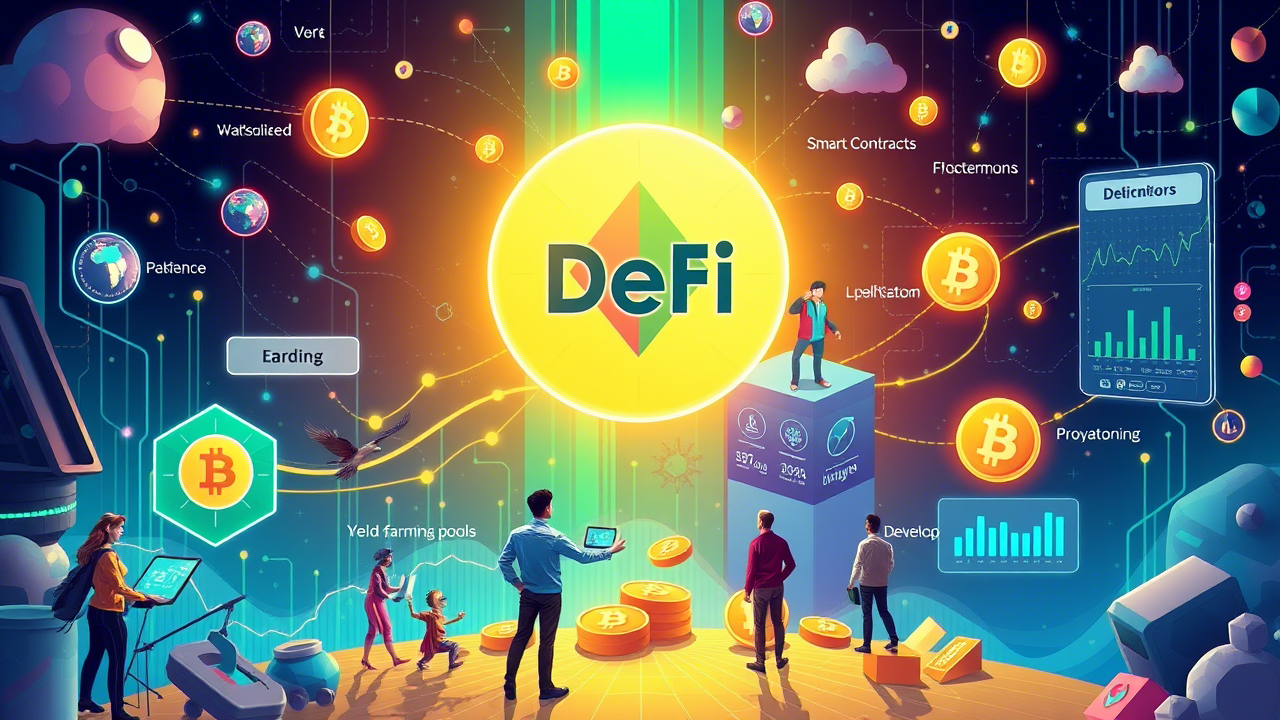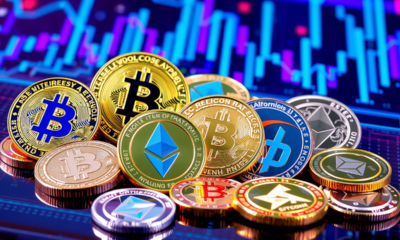DeFi & Yield Farming
The Role of Oracles in DeFi Ecosystems: Navigating the Intersection of Blockchain and Real-World Data

|
Getting your Trinity Audio player ready...
|

The Role of Oracles in DeFi Ecosystems
Introduction
The decentralized finance (DeFi) ecosystem has rapidly emerged as a revolutionary force in the world of financial technology, offering a range of services such as lending, borrowing, trading, and staking without the need for traditional financial intermediaries. At the heart of this innovation lies the concept of smart contracts—self-executing agreements with the terms of the transaction directly written into code. However, smart contracts alone cannot access real-world data, which is where oracles come into play. Oracles are crucial components that bridge the gap between blockchain and off-chain data, enabling DeFi applications to make informed decisions and execute transactions based on external information.
What Are Oracles?
Oracles are third-party services that provide data to smart contracts. They act as intermediaries, fetching and verifying real-world data and making it available on the blockchain. These data sources can include price feeds, weather data, sports scores, and even random numbers. The primary function of oracles is to ensure that smart contracts have access to accurate and reliable data, which is essential for the proper functioning of DeFi protocols.
The Importance of Oracles in DeFi
- Data Accuracy and Reliability
- Oracles ensure that the data used by smart contracts is accurate and up-to-date. This is particularly important for financial applications where even small inaccuracies can have significant consequences.
- For example, in a decentralized lending platform, the interest rate and collateral ratios are often determined by external price feeds. If these feeds are inaccurate, users could face liquidation or other financial losses.
- Enhanced Security
- Oracles play a vital role in enhancing the security of DeFi applications. By using multiple oracles and data sources, DeFi protocols can reduce the risk of manipulation and ensure that the data is tamper-proof.
- Some oracles use blockchain-based consensus mechanisms to verify data, adding an extra layer of security.
- Transparency and Trust
- The transparency of oracles contributes to the overall trust in DeFi ecosystems. Users can verify the data sources and the processes used to fetch and validate the data.
- This transparency is crucial for building user confidence and fostering a more robust and resilient DeFi market.
- Automation and Efficiency
- Oracles enable the automation of complex financial processes, making DeFi applications more efficient and user-friendly.
- For instance, decentralized exchanges (DEXs) use oracles to automatically update the prices of trading pairs, ensuring that trades are executed at fair and accurate rates.
Types of Oracles
- Software Oracles
- Software oracles retrieve data from online sources such as APIs, websites, and databases.
- They are often used for price feeds, weather data, and other types of information that can be easily accessed via the internet.
- Hardware Oracles
- Hardware oracles collect data from physical devices such as sensors and IoT devices.
- They are useful in applications that require real-time data, such as smart city projects or supply chain management.
- Inbound and Outbound Oracles
- Inbound oracles provide data to smart contracts, while outbound oracles send data from smart contracts to external systems.
- Both types are essential for the seamless operation of DeFi protocols.
- Centralized and Decentralized Oracles
- Centralized oracles are controlled by a single entity, which can pose a risk of manipulation and single points of failure.
- Decentralized oracles, on the other hand, use a network of nodes to fetch and validate data, reducing the risk of bias and increasing reliability.
Challenges and Solutions
- Data Manipulation and Bias
- One of the primary challenges in using oracles is the risk of data manipulation. Centralized oracles can be compromised, leading to incorrect data being fed into smart contracts.
- Solution: Decentralized oracles, such as Chainlink, use a network of nodes to gather and validate data, making it much harder for any single entity to manipulate the information.
- Single Points of Failure
- Centralized oracles can fail due to technical issues or malicious attacks, leading to the disruption of DeFi applications.
- Solution: Redundancy and fault tolerance are built into decentralized oracles, ensuring that the system remains operational even if some nodes fail.
- Latency and Consistency
- Data latency can be a significant issue, especially in fast-moving markets where real-time data is crucial.
- Solution: Advanced oracles use high-speed data retrieval and consensus mechanisms to minimize latency and ensure consistent data delivery.
Practical Tips for Using Oracles in DeFi
- Choose Reliable Oracles
- Research and select oracles with a proven track record of reliability and security.
- Look for oracles that use decentralized networks and have strong community support.
- Verify Data Sources
- Always verify the data sources used by the oracles. Ensure that they are reputable and provide accurate and timely information.
- Use multiple oracles to cross-verify data and reduce the risk of errors.
- Monitor Oracle Performance
- Regularly monitor the performance of the oracles used in your DeFi applications.
- Use tools and dashboards to track data accuracy and latency.
- Implement Data Validation Mechanisms
- Incorporate data validation mechanisms into your smart contracts to ensure that the data received from oracles is accurate and consistent.
- Use consensus algorithms and other techniques to filter out invalid or manipulated data.
- Stay Informed About Updates
- Keep up-to-date with the latest developments in the oracle space. New technologies and improvements are constantly being introduced.
- Follow industry news and participate in community discussions to stay ahead of the curve.
Case Studies
- Aave and Chainlink
- Aave, a leading DeFi lending platform, uses Chainlink oracles to fetch price data for various assets.
- This ensures that the interest rates and collateral requirements are always based on the most accurate and up-to-date market prices.
- Uniswap and Band Protocol
- Uniswap, a popular decentralized exchange, leverages Band Protocol oracles to provide reliable price feeds for its trading pairs.
- This helps to maintain fair and transparent trading conditions for all users.
- Synthetix and Pyth Network
- Synthetix, a platform for synthetic assets, uses Pyth Network oracles to fetch real-time price data from multiple sources.
- This ensures that the synthetic assets are accurately priced, reducing the risk of arbitrage and market manipulation.
Future Trends
- Blockchain Interoperability
- As the DeFi ecosystem continues to grow, the need for interoperability between different blockchains will increase.
- Oracles will play a crucial role in enabling seamless data exchange between these disparate networks.
- Advanced Data Analytics
- Future oracles will likely incorporate advanced data analytics and machine learning techniques to provide more sophisticated and actionable insights.
- This could lead to the development of new DeFi applications that leverage predictive analytics and other advanced data-driven technologies.
- Regulatory Compliance
- As DeFi gains more mainstream adoption, regulatory compliance will become increasingly important.
- Oracles will need to meet stringent data privacy and security standards to ensure that DeFi applications can operate within legal frameworks.
Conclusion
The role of oracles in DeFi ecosystems cannot be overstated. They are the lifeline that connects smart contracts to the real world, providing the data necessary for the proper functioning of decentralized applications. By understanding the importance of oracles and implementing best practices, DeFi developers and users can build more secure, transparent, and efficient financial systems. Whether you are a developer looking to integrate oracles into your DeFi project or a user seeking to navigate the DeFi landscape, the insights and tips provided in this article can help you make informed decisions and stay ahead of the curve.
Key Takeaway: Oracles are essential for the success of DeFi ecosystems, enabling smart contracts to access and verify real-world data. Choose reliable oracles, verify data sources, and implement validation mechanisms to ensure the security and efficiency of your DeFi applications.
DeFi & Yield Farming
Advanced Tokenomics: Creating Sustainable Incentive Models


Advanced Tokenomics: Creating Sustainable Incentive Models
Introduction
In the rapidly evolving world of cryptocurrencies and decentralized finance (DeFi), the term “Advanced Tokenomics” has gained considerable attention. Understanding advanced tokenomics is essential for the development of sustainable incentive models, which are key to ensuring the longevity and effectiveness of blockchain projects. In this article, we will delve into the principles of advanced tokenomics, explore its importance, and provide practical insights into crafting sustainable incentive models that can thrive in a competitive market.
What is Tokenomics?
Tokenomics combines “token” and “economics” to describe the economic model that underpins a cryptocurrency or digital token. It encompasses the creation, distribution, and circulation of tokens within a cryptocurrency ecosystem and aims to create a balanced economic environment that promotes growth, sustainability, and user engagement.
Key Components of Tokenomics
- Token Supply: Determines how many tokens will be created, which can be fixed or variable.
- Token Distribution: Details how tokens are allocated among stakeholders, including founders, investors, and the community.
- Token Utility: Explains the purpose that a token serves within its ecosystem, whether as a means of payment, governance, or stake-weighted voting.
- Incentives: Strategies that reward early adopters, contributors, and stakeholders to promote interaction and investment within the ecosystem.
The Importance of Advanced Tokenomics
Advanced tokenomics goes beyond basic principles to create more sophisticated models that consider market dynamics, user behavior, and long-term viability. By integrating advanced tokenomics into project designs, developers can address several critical areas:
Ensuring Long-Term Sustainability
- Market Stability: Advanced models can mitigate price volatility, which is often experienced in the cryptocurrency market. Techniques like dynamic supply adjustments can assist in maintaining stability.
- User Retention: Sustainable incentive models encourage users to remain engaged over time through staking rewards or loyalty programs.
Aligning Incentives
Creating models where the interests of different stakeholders are aligned is crucial. When all parties—users, developers, and investors—benefit from the growth of an ecosystem, it promotes collaboration and reduces conflict.
Fostering Community Ownership
Incorporating community-driven principles fosters a sense of ownership among token holders. Mechanisms such as decentralized governance can empower users to have a say in the protocol’s future, enhancing commitment and loyalty.
Crafting Sustainable Incentive Models
Creating an effective incentive model requires careful consideration and planning. Here are several strategies to keep in mind:
Define Clear Token Utility
Establishing a clear purpose for your token can enhance its value. Tokens could be utilized for transactions, used in governance, or serve as collateral in DeFi protocols. The clearer the utility, the easier it is to attract users and investors.
Implement Staking Mechanisms
Staking allows users to lock up their tokens in exchange for rewards, thus ensuring that they have skin in the game. This not only incentivizes holding but also contributes to network security. Consider deploying a tiered staking system to reward larger stakeholders while still accommodating smaller holders.
Utilize Buyback and Burn Strategies
This strategy involves the project using a percentage of its revenue to buy back tokens from the market and subsequently burn them, reducing the total supply. This approach can increase rarity and encourage upward price movements, all while demonstrating the project’s commitment to sustainability.
Create Incentives for Contributions
Encouraging user participation and contributions, whether through development, marketing, or community support, fosters a vibrant ecosystem. Consider implementing bounties, bonuses, or referral rewards to stimulate activity within your platform.
Monitor and Adapt
The cryptocurrency landscape is highly dynamic. Regular assessment of your tokenomics model is crucial. Use analytics to track user behavior and market trends, and be prepared to adapt your strategies as necessary. Flexibility can be your strongest asset in maintaining sustainability.
Examples of Successful Advanced Tokenomics
Ethereum
Ethereum implements a robust economic model that includes the Ether token as a means of transaction and gas fees, a well-defined supply schedule, and robust staking incentives through Ethereum 2.0. This blend of utility and user incentivization has propelled its growth and adoption.
Binance Smart Chain (BSC)
Binance Smart Chain employs a dual-token system comprising BNB for transaction fees and governance, alongside many tokens in its DeFi ecosystem. Its incentive models provide liquidity mining and yield farming opportunities, driving user engagement and transaction volume.
Conclusion
Advanced tokenomics plays an essential role in building sustainable incentive models within the blockchain ecosystem. By utilizing clear token utility, implementing effective staking mechanisms, and continuously monitoring user engagement, projects can create models that contribute to long-term growth and community trust.
Leveraging advanced tokenomics enhances not only the project’s financial health but also fosters an engaged community that feels valued and invested in the ecosystem’s future. As the blockchain space continues to evolve, embracing these principles will be critical for developers looking to make their mark.
Call to Action
If you’re a project developer or a crypto enthusiast looking to explore the potential of advanced tokenomics further, start by reviewing your current incentive models. Apply these insights to create robust structures that support sustainability and community engagement.
DeFi & Yield Farming
Introduction to Liquidity Pools and How They Work


Introduction to Liquidity Pools and How They Work
In the rapidly evolving world of cryptocurrency and decentralized finance (DeFi), liquidity pools have emerged as a fundamental concept. Understanding liquidity pools and how they work can not only enhance your knowledge of the DeFi space but also present new opportunities for investment and trading.
What are Liquidity Pools?
Liquidity pools are collections of digital assets or tokens held in a smart contract within a decentralized exchange (DEX). These pools provide liquidity, enabling traders to buy and sell tokens without needing a single buyer or seller to facilitate the transaction. Instead, the liquidity is pooled together, allowing for seamless transactions and price stability.
The Importance of Liquidity Pools
Liquidity is crucial for any trading platform, especially in the cryptocurrency market, where asset prices can fluctuate wildly. Without liquidity, users would struggle to buy or sell assets quickly or at fair prices. Liquidity pools alleviate this problem in several ways:
- Facilitating Trades: Enables users to trade 24/7 without the need for an order book.
- Reduced Slippage: With sufficient liquidity, the price impact of large trades is minimized.
- Earning Potential: Users can earn passive income by providing liquidity to these pools.
How Do Liquidity Pools Work?
1. The Mechanism of Liquidity Pools
Liquidity pools operate through smart contracts. When users deposit tokens into a liquidity pool, they receive liquidity provider (LP) tokens in return. These LP tokens represent the user’s share in the pool and can be traded, sold, or redeemed for the underlying assets.
Here’s how the process works:
- Depositing Assets: Users provide tokens by depositing them into the liquidity pool, typically in pairs (e.g., ETH/USDT).
- Automated Market Maker (AMM): Transactions occur through an AMM model, which determines the prices based on the ratio of the assets in the pool. The pricing formula often used is ( x \times y = k ), where ( x ) and ( y ) are the respective quantities of two tokens in the pool, and ( k ) is a constant.
- Earning Fees: Liquidity providers earn a portion of the trading fees generated from transactions that occur in the pool, proportional to their share.
2. Types of Liquidity Pools
While all liquidity pools share the same primary objective—providing liquidity—different types of liquidity pools cater to varied trading strategies:
- Stablecoin Pools: These pools contain stablecoins like USDC or DAI, making them less volatile.
- Single Asset Pools: Users can provide a single type of token, simplifying the process.
- Reward Pools: Some pools provide users with additional rewards in the form of governance tokens or other incentives.
3. The Risks Associated with Liquidity Pools
While liquidity pools can be lucrative, they also come with their share of risks. Understanding these risks is crucial for making informed decisions:
- Impermanent Loss: This occurs when the value of assets in the pool changes compared to holding them separately. The more volatile the assets, the higher the potential impermanent loss.
- Smart Contract Risks: Bugs or vulnerabilities in a smart contract can lead to loss of funds.
- Market Risks: Sudden market movements can affect the liquidity pool’s performance.
Benefits of Liquidity Pools
Engaging with liquidity pools can offer several advantages:
1. Passive Income
Liquidity providers earn fees from trades conducted in the pool. This passive income can be significant, especially in high-volume pools.
2. Access to DeFi Services
By participating in liquidity pools, users gain access to various DeFi services, including yield farming, lending, or borrowing.
3. Token Appreciation
In addition to trading fees, LP tokens themselves can appreciate in value, offering an additional return on investment.
Conclusion: Are Liquidity Pools Right for You?
Understanding liquidity pools and how they work is essential for anyone looking to engage in the DeFi ecosystem. Whether you are aiming to earn passive income, participate in decentralized finance, or hedge against market volatility, liquidity pools present numerous opportunities.
Call to Action
Before diving in, conduct thorough research and consider the risks involved. Start with smaller amounts and increase your investment as you grow more comfortable with the mechanics of liquidity pools.
By exploring liquidity pools and how they function, you’ve taken a step towards unlocking a new dimension of financial opportunities. Embrace the world of decentralized finance and keep learning to maximize your potential!
DeFi & Yield Farming
Step-by-Step Guide to Connecting Your Wallet to DeFi Platforms


Step-by-Step Guide to Connecting Your Wallet to DeFi Platforms
The decentralized finance (DeFi) revolution has transformed the way we think about finance. With the rise of DeFi platforms, users can lend, borrow, trade, and earn interest on their cryptocurrencies without traditional banks. However, to fully engage with this exciting landscape, you need to connect your digital wallet. This Step-by-Step Guide to Connecting Your Wallet to DeFi Platforms will provide you with everything you need to get started successfully.
What is a DeFi Platform?
Before we delve into the specifics of wallet connection, let’s briefly explore what DeFi platforms offer. DeFi platforms are decentralized applications (dApps) built on blockchain technology, primarily Ethereum. They facilitate various financial services, including:
- Lending and Borrowing: Users can lend their assets to others or borrow against collateral.
- Decentralized Exchanges (DEXs): These platforms allow users to trade cryptocurrency directly with one another.
- Yield Farming: This practice enables users to earn rewards by providing liquidity to the market.
The core principle of DeFi is the removal of intermediaries, offering users full control of their assets.
Why Connect Your Wallet?
Connecting your wallet to a DeFi platform allows you to interact directly with smart contracts. Your wallet acts as your gateway to participate in DeFi activities—be it trading NFTs, earning interest, or liquidity mining.
Types of Wallets
There are two main types of wallets commonly used in the DeFi space:
- Hot Wallets: These are connected to the internet and are more user-friendly, making them suitable for everyday transactions.
- Cold Wallets: These are hardware wallets that store your assets offline, providing increased security against hacks.
Step-by-Step Guide to Connecting Your Wallet to DeFi Platforms
Step 1: Choose Your Wallet
First, decide which wallet you want to use. Some popular options include:
- MetaMask: An easy-to-use browser extension and mobile app.
- Trust Wallet: A mobile wallet for both Android and iOS with a user-friendly interface.
- Ledger: A hardware wallet that offers advanced security features.
Step 2: Create and Fund Your Wallet
Once you’ve chosen your wallet, follow these steps:
- Download and Install: Download the wallet application or browser extension.
- Create a New Wallet: Follow the prompts to create a new wallet. Ensure you write down your recovery seed phrase and store it securely.
- Fund Your Wallet: Transfer some cryptocurrency (often ETH for Ethereum-based DeFi platforms) into your wallet. You can buy crypto through exchanges like Coinbase or Binance.
Step 3: Visit a DeFi Platform
Now that your wallet is set up and funded, you can visit a DeFi platform. Some popular platforms include:
- Uniswap: A leading decentralized exchange.
- Aave: A platform for lending and borrowing.
- Compound: Focused on lending with algorithmic interest rates.
Step 4: Connect Your Wallet
Here are the steps to connect your wallet to a DeFi platform:
- Initiate Connection: Look for the “Connect Wallet” button on the DeFi platform’s homepage.
- Select Your Wallet: Choose the wallet you are using (e.g., MetaMask, Trust Wallet).
- Authorize Connection: A pop-up will appear asking you to confirm that you want to connect your wallet. Click “Connect” to proceed.
- Permission Settings: Some platforms require additional permissions to access your assets. Review and grant the necessary permissions.
Step 5: Start Interacting with DeFi
Once your wallet is connected, you can start using the platform. You can swap tokens, provide liquidity, or stake your assets depending on the platform’s offerings.
Best Practices for Using DeFi Platforms
- Security: Always ensure you’re on the correct website. Phishing attacks are common in DeFi.
- Gas Fees: Be aware of transaction fees (gas fees) associated with interactions. These can vary based on the network’s congestion.
- Research: Investigate the DeFi platform and its community before investing. Look for audits and reviews.
Conclusion: Join the DeFi Revolution
This Step-by-Step Guide to Connecting Your Wallet to DeFi Platforms has provided you with the knowledge needed to navigate the DeFi landscape safely and efficiently. With your wallet connected, you can explore endless opportunities for earning and growing your cryptocurrency assets.
Call to Action
Are you ready to dive into DeFi? Choose your wallet today and start exploring the financial freedom that decentralized finance has to offer!
-

 Security & Privacy4 months ago
Security & Privacy4 months agoAdvanced Techniques for Securing Multi-Signature Wallets
-

 Crypto Basics4 months ago
Crypto Basics4 months agoHow to Spot Fake News in the Crypto Space: A Comprehensive Guide for Savvy Investors
-

 Video4 months ago
Video4 months agoTop Mistakes New Investors Make in Crypto
-

 Video4 months ago
Video4 months agoThe Easiest Way to Buy NFTs: A Step-by-Step Guide
-

 Video4 months ago
Video4 months agoPublic vs Private Blockchain | Difference Between Public and Private Blockchain
-

 Investment Strategies4 months ago
Investment Strategies4 months agoPsychological Aspects of Trading: Mastering Emotions for Financial Success
-

 Web3 & Metaverse4 months ago
Web3 & Metaverse4 months agoTitle: Implementing Zero-Knowledge Proofs in Web3 Applications: A Comprehensive Guide to Security and Privacy
-

 Regulations & Policy Updates4 months ago
Regulations & Policy Updates4 months agoLegal Frameworks for Launching Security Tokens: A Comprehensive Guide for 2025






































